Sonitpur, Assam: “Mothers are now able to reach us even during the monsoon,” said Arundhati Das, 52, pointing at the asphalt road outside a one-room government health sub-centre in Bhojkhowa village. The centre serves a population of 10,000 in Assam’s flood-prone Sonitpur district and Das has been in charge of it since 2001. There is a bed in one corner, and a baby weighing scale on top of it. Hanging on the wall are cloth pouches with immunisation cards to keep track of the vaccinations that children in the area have received.
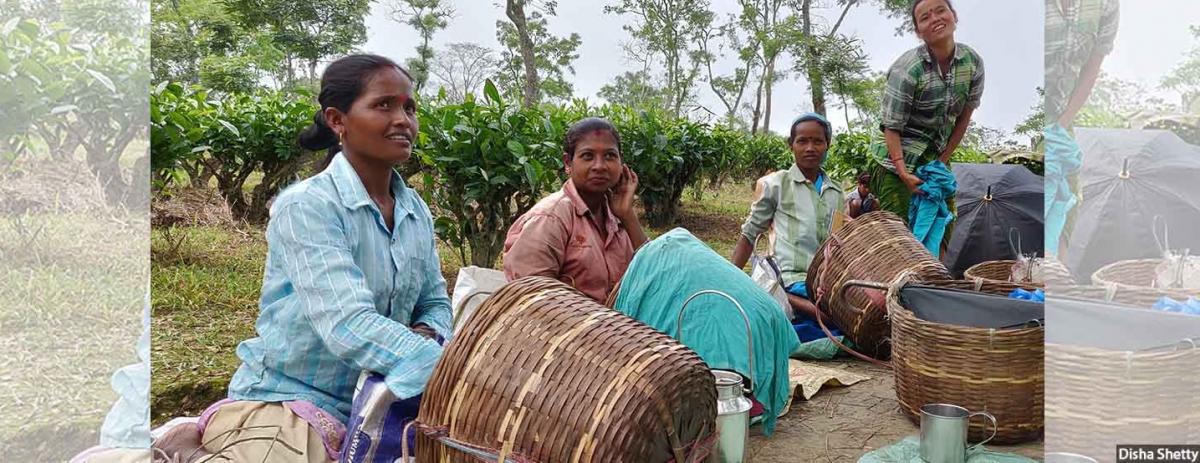
Bilasi Urau (left), 32, a worker in Assam’s tea plantations, is afraid to get pregnant. “We all know someone who has died during pregnancy, and the situation makes me feel that it is better not to have children at all,” said the mother of a 10-year-old boy.
The sub-centre that provides primary health care—iron tablets, information about government schemes, immunisation and contraceptives—gets flooded every monsoon. “The mothers are then forced to stay home,” said Das. Over 30 of Assam’s 33 districts are inundated by the Brahmaputra annually, washing away crops and crippling the state’s rural economy.
Das does not remember when the road outside her sub-centre was built, but said it enables access to health care and tetanus injections—which reduces the chances of infection among mothers right after childbirth. “Roads are helping save lives,” Das added.
For every 100,000 live births, 130 women die in India due to pregnancy-related complications, according to Niti Aayog, the think-tank of the government. While Kerala has the lowest maternal mortality rate (MMR) of 46, Assam’s MMR of 237 is double India’s average and is currently higher than Zambia’s (224), according to World Bank data (Poland’s MMR of three is the lowest in the world).
Assam’s current MMR status might overshadow the strides the state has made in maternal healthcare. In just over a decade, Assam has reduced its MMR from 480 to 237–that is a greater than 50% reduction.
Maternal mortality is high where access to skilled and emergency care is either unavailable or limited, said Dileep Mavalankar, director, Indian Institute of Public Health (IIPH) in Gandhinagar. “Wherever that situation has improved, either in the government or the private sector, the mortality rate has gone down.”
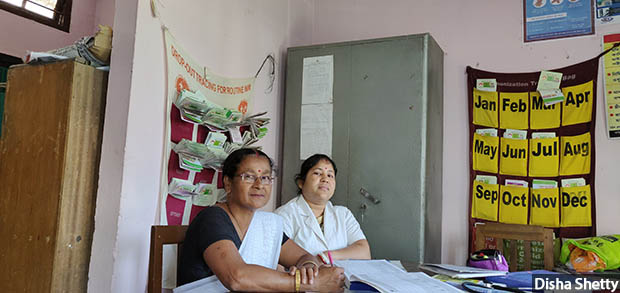
(L-R) Arundhati Das, 52, a community health worker at the Bhojkhowa health sub-centre with her colleague Meera Bhuyaa, 31. Das credits the road outside the sub-centre for improved health services in the area.
The 15,000 roads constructed in Assam under the Pradhan Mantri Gram Sadak Yojana launched in 2000 have helped improve access to health care, according to the health workers and doctors that IndiaSpend spoke to across five villages in Sonitpur district. However, there are issues that Assam needs to address.
Anaemia among pregnant women
Rukiya Begum, 44, is an accredited social health activist (ASHA) in Tengabasti village in Sonitpur district. The sub-centre near her village is being repaired, so for now, health officials are using her one-room brick home. There is a plastic chair and a table covered with green cloth. On it is a box of iron tablets that Rukiya is trained to give pregnant women to prevent anaemia.
Anaemic women are at a higher risk of developing pregnancy-related complications, found a 2016 study that looked at births in five government medical colleges in Assam. Anaemic mothers are more likely to develop infections after childbirth, and their babies tend to be smaller. In Assam, as in the rest of India, nearly half of all pregnant women in the age group of 15-49 year are anaemic.
A pregnant woman with anaemia is twice as likely to die during childbirth, according to a 2018 study published in the medical journal Lancet.
Rukiya talks about her 18-year-old sister-in-law who died during childbirth in 2007. “Since the area was flooded, it took us a few hours to get her to hospital. She bled to death after childbirth,” said Rukiya, who had just become an ASHA worker then, and had limited training.
A woman with anaemia is low on haemoglobin, which reduces her body’s ability to carry oxygen to all the organs. As a severely anaemic woman bleeds after childbirth, her heart has to pump at a higher rate to bring more blood to the organs to make up for the limited concentration of oxygen in the blood, increasing the chances of a cardiac arrest. “The doctor then has very little time to give her blood,” explained Ravikant Singh, a public health expert and founder of Doctors for You, an NGO that works in 12 states across India, including Assam.
Of Assam’s 33 districts, 10 have no blood banks, and if a woman needs blood following a C-section, there is none.
Unsafe abortions
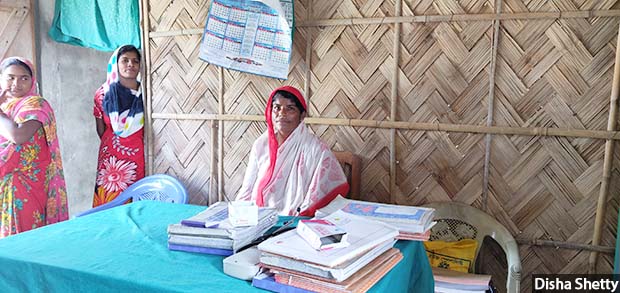
Rukiya Begum is an ASHA worker in Tengabasti village in Sonitpur district of Assam. Responsible for distributing contraceptives to women in the village, she says supplies have not arrived for three months.
As an ASHA worker, Rukiya’s job also involves dispensing contraceptives. She ran out of supplies three months back but said this was the first time it had happened.
A 2006 study established the link between access to contraceptives and maternal deaths. Providing women with options to plan their families would avert 32% of global maternal deaths and 10% of children deaths, it said. Contraceptives allow a woman to avoid an unplanned pregnancy.
In Assam, 22% of women rely on oral contraceptive pills–more than five times the national average. However, the uptake of family planning methods is deficient in Assam. Only 37% of married women in the age group of 15-49 use any new means of family planning. This number stands at 47.8% for the rest of India.
“Oral contraceptives and injections have a high rate of discontinuation as women might forget to take them,” said Roger Rochat, former director of reproductive health at the Centers for Disease Control and Prevention (CDC), US, and professor of global health at Emory University’s Rollins School of Public Health.
To terminate an unwanted pregnancy, the women either opt for over-the-counter abortion pills or turn to a quack. When unskilled practitioners perform abortion in a less than sterile environment, it increases the chances of infection.
“A few months back a woman in a neighbouring village died after taking abortion pills,” said Rukiya.
Is it easy to get these pills?
“Yes, the medical shops stock them, but I do not know about them,” she said, unwilling to provide more details.
In rural areas such as Tengabasti, in the absence of enough diagnostic labs, it can be a while before a woman finds out she is pregnant. Once the pregnancy is older than 20 weeks, a doctor cannot terminate it legally. Desperate, women often turn to quacks or private practitioners.
“Even in the best healthcare facility abortion can be risky, and death may occur,” said Ajit Virkud, a Mumbai-based obstetrician and gynaecologist and author of several medical textbooks. “In rural areas, most abortions are unsafe, specifically those done by people who are not qualified.” These deaths might never be reported as the procedures are illegal. .
One of the solutions to the problem is to provide contraceptive options (injections and intrauterine device or IUD) that are acceptable to people, said Rochat. “Another is to provide skilled practitioners to conduct abortion services.”
Maternal deaths that occur in the first three months of pregnancy are a significant contributor to MMR.
Neglect of tea garden workers
The most significant blind spot in Assam’s maternal health is the neglect of women working in its tea estates–803 spread across 27 districts–that report a disproportionately high number of maternal deaths. It was found that in the tea gardens of Assam, anaemia among women was almost universal, IndiaSpend reported in April 2017.
It was a pleasant May afternoon in the Durrung tea estate, one of the oldest in Assam. Rain comes early here, and the temperature is in the mid-20 degrees Celsius. A group of women wearing Assam’s traditional mekhela chador (a kind of saree) spread out plastic sheets on a mud road skirting the tea plantation. Some have young babies clinging to them, others have toddlers running around. The women are taking a break for the first time since 8 am.
In Assam’s tea gardens, it is the women who pluck the tea leaves–a painstaking process. The men water the plants and spray pesticides.
Bilasi Urau, 32, has grown up in the tea estate, as have all the other women sitting to have lunch with her. They live in villages spread across hundreds of acres of the estate. All the women know someone in their village who died during pregnancy.
Do women have access to healthcare?
“Yes, if we need anything, we have to inform the sardar [supervisor]. He will take us out [to hospital or to a doctor],” Urau said.
Can they not go out without permission?
“We can. However, there is no guarantee we will be allowed to return, so we do not. When we do go out we have to provide the address of the place we are visiting,” Urau said.
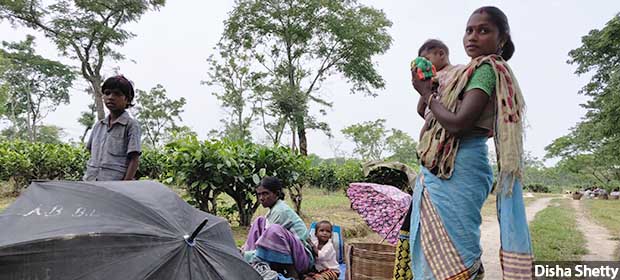
Construction of roads that improve access to health centres, contraceptives and tetanus injections are some of the basics helping save mothers in flood-prone Assam. The gains, though, are yet to reach its tea-garden workers.
The supervisor was cycling around to make sure the women did not rest when IndiaSpend visited.
Maternal deaths are disproportionately high among tea estate workers, found a study published in February this year. Researchers who investigated 150 maternal deaths discovered that 69% of all deaths were among the tea garden community. Half of the deaths were among first-time mothers, and more than half of those who died had husbands who were temporary workers.
A high rate of mortality among pregnant tea-garden workers (mainly Adivasis–indigenous tribal peoples) was also highlighted in a 2018 report by Nazdeek, a legal empowerment organisation.
Most of the workers in the tea gardens are from marginalised communities from central India. They were brought to Assam in the early 1900s under British colonial rule. These communities continue to earn lower than the state’s minimum wage, and 60-70% of the workers are hired-at-will with few or no benefits, according to Nazdeek’s report.
“The women have to depend on someone to take them out of the tea garden if they go into labour. In complicated cases, such delays could lead to death. The high rate of anaemia is another reason for the deaths,” said Pranti Dutta, who studied maternal deaths in four districts of Assam for her PhD thesis at the Indian Institute of Technology, Guwahati.
As this reporter and her translator prepared to leave, the women began eating–rice and what looked like green chilli chutney, the only meal the women will have between 8 am and 4 pm. “Malnutrition is certainly a problem in the tea estates not just because of the poor economic conditions but also because of the unavailability of nutritious food,” admitted Purnananda Khaund, chief medical officer of Amalgamated Plantations Pvt. Ltd–the enterprise carved out of the erstwhile Tata Tea Ltd.
Last year, the Assam government launched the Wage Compensation Scheme for Pregnant Women in tea gardens, reported India Today on October 2, 2018. Under this cash transfer programme, pregnant women working in the tea gardens are provided with Rs 12,000 by the government. “The women would get this money in instalments through the pregnancy and after childbirth,” said Krishna Kemprai, joint director, health services for Sonitpur district. For women who make Rs 167 per day, providing monetary assistance to buy nutritious food could help improve their health, at least marginally.
Eight generations have passed since these tea estate workers were brought to Assam by the British. The villages have grown, and a few villagers have found employment outside the estate, but not all. “There are only so many people the tea estates can absorb. This situation is critical and needs a sincere political solution,” said Khaund.
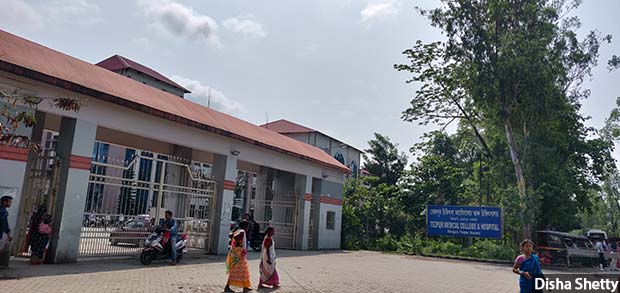
When a maternal death is reported, a district-level committee is constituted to examine the causes. The mechanism does not function effectively, however. Only a few deaths are reported to district-level hospitals such as the Tezpur Medical College and Hospital (above). Many go unreported.
Unregistered deaths
Before it works to save its dying mothers, India needs to identify maternal deaths. India is lagging when it comes to registering births and deaths on to the Civil Registration and Vital Statistics portal. Around 83.60% of births and 67.40% of deaths are registered in India, according to data from the World Health Organization. India’s neighbour Sri Lanka registers 90% or more of both births and deaths, and Brazil, a developing country like India, registers close to 99%.
Maternal deaths might not be registered when the delivery is done at home or as a result of an illegal abortion. “If a primary health centre or rural hospital registers too many maternal deaths the administration could come down heavily on them and so there is a tendency not to register them if no one is watching,” said Singh from Doctors for You.
This is not to say that there is no system in place to investigate maternal deaths. In theory, every death needs to be investigated, and committees need to be formed at the district level.
“When we come across maternal deaths we hold a meeting to discuss the reasons and submit a report,” said Jagannath Patar, associate professor at the obstetrics and gynaecology department at the Tezpur Medical College and Hospital, Sonitpur. However, there are limitations to such investigations. There is no facility or personnel to conduct an autopsy at the hospital. “We are not even sure if the reports we make have an impact or the feedback reaches those at the primary healthcare centres,” Patar added.
The feedback does not reach the intended, the Nazdeek report confirmed.
There is another way to make sure maternal deaths are recorded accurately. “Record all deaths of women in the reproductive age of 15 to 49 and then investigate if that woman was pregnant or had recently delivered a baby. That way you will not miss any deaths,” advised Mavalankar of the IIPH.
This process does not have to be expensive. Countries such as Sri Lanka investigate all maternal deaths at low cost, a model that can be replicated, according to studies. “India has not paid attention to recording of all deaths, including maternal deaths,” said Mavalankar.
Registering each death and investigating the cause behind them would help identify the problems and its solutions, which in turn will help more mothers live.
(Shetty is a reporting fellow at IndiaSpend.)
This report was supported by the International Women’s Media Foundation’s (IWMF) Reporting Grants for Women’s Stories.
We welcome feedback. Please write to respond@indiaspend.org. We reserve the right to edit responses for language and grammar.
This story was first published here on HealthCheck.
Courtesy: India Spend